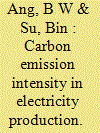|
|
|
Sort Order |
|
|
|
Items / Page
|
|
|
|
|
|
|
| Srl | Item |
| 1 |
ID:
150661


|
|
|
|
|
| Summary/Abstract |
With respect to changes in the energy systems of many countries, electricity consumption in households is an important topic. Extensive research has investigated the various determinants of electricity consumption. However, insights into how specific sociodemographic, behavioural, and attitudinal determinants influence residential electricity consumption are still scarce. In this study, we used hierarchical regression analysis to systematically investigate these determinants (including household engagement in electricity saving) along with a wide range of other measures in a sample of German households (N=763). Special attention was given to households with adolescents and children by analysing the influence of the number of adolescents on electricity consumption in a path model. Our results indicate that sociodemographic influences can be explained by the purchasing and use behaviours of residents. Our findings also suggest that the use of behavioural information provides a more detailed picture of the conditions of electricity consumption and thus allows for more appropriate policy planning.
|
|
|
|
|
|
|
|
|
|
|
|
|
|
|
|
| 2 |
ID:
150648


|
|
|
|
|
| Summary/Abstract |
The European Commission's Target Electricity Model (TEM) aims to integrate EU electricity markets. This paper estimates the potential benefit of coupling interconnectors to increase the efficiency of trading day-ahead, intra-day and balancing services across borders. Further gains are possible by eliminating unscheduled flows and avoiding the curtailment of renewables with better market design. In the short run the gains could be as high as €3.9 billion/yr, more than 100% of the current gains from trade. About one-quarter of this total comes from day-ahead coupling and another third from shared balancing. If shared balancing is so valuable, completing the TEM becomes more urgent, and regulators should ensure these gains are paid to interconnectors to make the needed investment in the cross-border links more commercially profitable.
|
|
|
|
|
|
|
|
|
|
|
|
|
|
|
|
| 3 |
ID:
150638


|
|
|
|
|
| Summary/Abstract |
China hosts a large amount of building stocks, which is nearly 50 billion square meters. Moreover, annual new construction is growing fast, representing half of the world's total. The trend is expected to continue through the year 2050. Impressive demand for new residential and commercial construction, relative shorter average building lifetime, and higher material intensities have driven massive domestic production of energy intensive building materials such as cement and steel. This paper developed a bottom-up building stock turnover model to project the growths, retrofits and retirements of China's residential and commercial building floor space from 2010 to 2050. It also applied typical material intensities and energy intensities to estimate building materials demand and energy consumed to produce these building materials. By conducting scenario analyses of building lifetime, it identified significant potentials of building materials and energy demand conservation. This study underscored the importance of addressing building material efficiency, improving building lifetime and quality, and promoting compact urban development to reduce energy and environment consequences in China.
|
|
|
|
|
|
|
|
|
|
|
|
|
|
|
|
| 4 |
ID:
150669


|
|
|
|
|
| Summary/Abstract |
We study changes in the aggregate carbon intensity (ACI) for electricity at the global and country levels. The ACI is defined as the energy-related CO2 emissions in electricity production divided by the electricity produced. It is a performance indicator since a decrease in its value is a desirable outcome from the environmental and climate change viewpoints. From 1990 to 2013, the ACI computed at the global level decreased only marginally. However, fairly substantial decreases were observed in many countries. This apparent anomaly arises from a geographical shift in global electricity production with countries having a high ACI increasingly taking up a larger electricity production share. It is found that globally and in most major electricity producing countries, reduction in their ACI was due mainly to improvements in the thermal efficiency of electricity generation rather than to fuel switching. Estimates of the above-mentioned effects are made using LMDI decomposition analysis. Our study reveals several challenges in reducing global CO2 emissions from the electricity production sector although technically the reduction potential for the sector is known to be great.
|
|
|
|
|
|
|
|
|
|
|
|
|
|
|
|
| 5 |
ID:
150676


|
|
|
|
|
| Summary/Abstract |
We analyze the relationship between carbon intensity and EPI and find that the informational content of EPI is in large part explainable by the state of economic growth and level of carbon intensity, with the second variable being already an increasing function of emissions and a decreasing function of economic well being. Carbon intensity has the largest explanatory power for EPI rankings and consistently produces the correct, anticipated, negative sign in its relationship to EPI. Second in importance are the renewable energy sources, which also produce consistent results with respect to their impact on the EPI but with much lower explanatory power. Our results suggest that advanced countries should, as they are doing already, implement measures of high quality environmental content while measures for increasing economic growth, while controlling emissions, are appropriate for developing countries. A number of other energy policy implications and the use of new technologies are also discussed in the context of our analysis.
|
|
|
|
|
|
|
|
|
|
|
|
|
|
|
|
| 6 |
ID:
150656


|
|
|
|
|
| Summary/Abstract |
A decision-making model was constructed to assist remote Australian Indigenous communities select appropriate climate change mitigation programs. The Resilient Community and Livelihood Asset Integration Model (ReCLAIM) comprises six steps that focus on community assets and aspirations. The second of these steps is to determine the baseline carbon profiles of communities based on six sources of carbon emissions: materials, construction processes, stationary energy, transport, water systems and waste. The methodology employed an annualised lifecycle analysis of housing materials and construction, and an annual inventory of other emission sources. Profiles were calculated for two remote communities and compared to the Australian average and also average electricity consumption by remote communities in the Northern Territory.
|
|
|
|
|
|
|
|
|
|
|
|
|
|
|
|
| 7 |
ID:
150670


|
|
|
|
|
| Summary/Abstract |
In China, the national target for energy intensity reduction, when integrated with target disaggregation and information feedback systems, constitutes a numerical management system, which is a hallmark of modern governance. This paper points out the technical weaknesses of China's current numerical management system. In the process of target disaggregation, the national target cannot be fully disaggregated to local governments, sectors and enterprises without omissions. At the same time, governments at lower levels face pressure for reducing energy intensity that exceeds their respective jurisdictions. In the process of information feedback, information failure is inevitable due to statistical inaccuracy. Furthermore, the monitoring system is unable to correct all errors, and data verification plays a limited role in the examination system. To address these problems, we recommend that the government: use total energy consumption as the primary indicator of energy management; reform the accounting and reporting of energy statistics toward greater consistency, timeliness and transparency; clearly define the responsibility of the higher levels of government.
|
|
|
|
|
|
|
|
|
|
|
|
|
|
|
|
| 8 |
ID:
150650


|
|
|
|
|
| Summary/Abstract |
Photovoltaic (PV) Levelized Cost of Energy (LCOE) estimates are widely utilized by decision makers to predict the long-term cost and benefits of solar PV installations, but fail to consider local climate, which impacts PV panel lifetime and performance. Specific types of solar PV panels are known to respond to climate factors differently. Mono-, poly-, and amorphous-silicon (Si) PV technologies are known to exhibit varying degradation rates and instantaneous power losses as a function of operating temperature, humidity, thermal cycling, and panel soiling. We formulate an extended LCOE calculation, which considers PV module performance and lifespan as a function of local climate. The LCOE is then calculated for crystalline and amorphous Si PV technologies across several climates. Finally, we assess the impact of various policy incentives on reducing the firm's cost of solar deployment when controlling for climate. This assessment is the first to quantify tradeoffs between technologies, geographies, and policies in a unified manner. Results suggest crystalline Si solar panels as the most promising candidate for commercial-scale PV systems due to their low degradation rates compared to amorphous technologies. Across technologies, we note the strong ability of investment subsidies in removing uncertainty and reducing the LCOE, compared to production incentives.
|
|
|
|
|
|
|
|
|
|
|
|
|
|
|
|
| 9 |
ID:
150617


|
|
|
|
|
| Summary/Abstract |
European energy markets have undergone a major transformation as they have advanced towards market liberalisation and it is vital that the details of these developments be carefully examined. The success of liberalisation is based on smart regulation, which has been capable of providing solutions to unforeseen events in the process. Our paper seeks to contribute to existing understanding of the unexpected and collateral effects of the liberalisation process in the power system by examining a natural experiment that occurred in Spain in 2009. In that year, the electricity supply by distribution system operators disappeared. This change in retail market competition, as we demonstrate in this paper, has had an unexpected effect in terms of the system’s balancing requirements. We undertake a rigorous assessment of the economic consequences of this policy change for the whole system, in terms of its impact on final electricity prices.
|
|
|
|
|
|
|
|
|
|
|
|
|
|
|
|
| 10 |
ID:
150633


|
|
|
|
|
| Summary/Abstract |
Battery energy storage systems (BESSs) are expected to become a fundamental element of the electricity infrastructure, thanks to their ability to decouple generation and demand over time. BESSs can also be used to store electricity during low-price hours, when the demand is low, and to meet the demand during peak hours, thus leading to savings for the consumer. This work focuses on the economic viability of BESS from the point of view of the electricity customer. The analysis refers to a lithium-ion (Li-ion), an advanced lead-acid, a zinc-based, a sodium-sulphur (NaS) and a flow battery. The total investment and replacement costs are estimated in order to calculate the cumulated cash flow, the net present value (NPV) and the internal rate of return (IRR) of the investment. A parametric analysis is further carried out under two different assumptions: a) varying the difference between high and low electricity prices, b) varying the peak demand charges. The analysis reveals that some electrochemical technologies are more suitable than others for electric bill management applications, and that a profit for the customer can be reached only with a significant difference between high and low electricity prices or when high peak demand charges are applied.
|
|
|
|
|
|
|
|
|
|
|
|
|
|
|
|
| 11 |
ID:
150652


|
|
|
|
|
| Summary/Abstract |
Participation in demand response (DR) may affect a consumer's electric consumption pattern through consumption load curtailment, a shift in the consumption timing or increasing the utilization of distributed generation (DG). This paper attempts to provide empirical evidence of DR's effect on DG adoption by household consumers. By using the original Internet survey data of 5442 household respondents in Japan conducted in January 2015, we focus on the effect of the time-of-use (TOU) tariff on the purchasing intention of photovoltaic systems (PV). The empirical results show the following: 1) current TOU plan users have stronger PV purchase intentions than the other plan users, 2) respondents who are familiar with the DR program have relatively higher purchase intentions compared with their counterparts, and 3) when the respondents are requested to assume participation in the virtual TOU plan designed for the survey, which resembles plans currently available through major companies, 1.2% of the households have decided to purchase PV. In addition, we provide calculations of TOU's impacts on the official PV adoption and emissions reduction targets, and discuss policy recommendations to increase recognitions and participations in TOU programs.
|
|
|
|
|
|
|
|
|
|
|
|
|
|
|
|
| 12 |
ID:
150640


|
|
|
|
|
| Summary/Abstract |
In order to increase the attractiveness of electric vehicles (EVs), packages of policy incentives are provided in many countries. However, it is still unclear how effective different policy incentives are. Also, it is questionable that they have the same impact on different groups of people. In this study, based on a stated-choice experiment, the effect of several potential policy incentives on EV-adoption, as well as the influence of socio-psychological determinants are investigated, using constructs of the Transtheoretical Model of Change (TTM) and the Protection Motivation Theory (PMT).
|
|
|
|
|
|
|
|
|
|
|
|
|
|
|
|
| 13 |
ID:
150672


|
|
|
|
|
| Summary/Abstract |
Decision-making in Iceland has occurred without reference to economic valuations of the environmental impacts of energy projects. Environmental Impact Assessments, a legal requirement for nearly all energy projects in Iceland since 1994, have played an important role in identifying the environmental impacts of energy projects, and proposing mitigation measures. However, a purely qualitative description of environmental impacts is insufficient to ensure that they are accounted for equivalently with all of the other costs and benefits of a proposed project. Instead, as monetary information concerning the welfare gains or losses of proposed projects is not currently required to be provided to the licensing body, Orkustofnun, there is the potential for sub-optimal decision-making to occur. As this paper sets out, a broad variety of non-market valuation techniques already exist and could be applied to estimate the value of environmental benefits sacrificed to accommodate such developments. These methods and their outcomes could be incorporated within mandatory cost-benefit assessments for proposed Icelandic energy projects, communicating an estimate of the full welfare implications of approvals to decision-makers and the public alike, and fulfilling an OECD demand for the country to commence such processes.
|
|
|
|
|
|
|
|
|
|
|
|
|
|
|
|
| 14 |
ID:
150679


|
|
|
|
|
| Summary/Abstract |
Many people believe renewable energy sources to be capable of substituting fossil or nuclear energy. However there exist very few scientifically sound studies, which apply due diligence to substantiating this impression. In the present paper, the case of photovoltaic power sources in regions of moderate insolation is analysed critically by using the concept of Energy Return on Energy Invested (ERoEI, also called EROI). But the methodology for calculating the ERoEI differs greatly from author-to-author. The main differences between solar PV Systems are between the current ERoEI and what is called the extended ERoEI (ERoEI EXT). The current methodology recommended by the International Energy Agency is not strictly applicable for comparing photovoltaic (PV) power generation with other systems. The main reasons are due to the fact that on one hand, solar electricity is very material-intensive, labour-intensive and capital-intensive and on the other hand the solar radiation exhibits a rather low power density.
|
|
|
|
|
|
|
|
|
|
|
|
|
|
|
|
| 15 |
ID:
150675


|
|
|
|
|
| Summary/Abstract |
The importance of renewable energy as a response to climate change is universally acknowledged. However, its successful implementation requires public approval and cooperation. This study aims to identify the level of renewable energy acceptance in Korea by estimating Korean consumers’ additional willingness to pay (WTP) using the contingent valuation (CV) method, which is the most widely used to analyze consumer preferences. The estimation results indicate that Korean consumers are willing to pay an additional USD 3.21 per month for electricity generated with renewable energy. However, WTP in Korea is low relative to other advanced nations, indicating that these values could be influenced through policies aimed at improving knowledge and acceptance of renewable energy sources among Korean consumers.
|
|
|
|
|
|
|
|
|
|
|
|
|
|
|
|
| 16 |
ID:
150625


|
|
|
|
|
| Summary/Abstract |
European Union carbon emissions allowances (EUA) price fluctuations can affect electricity companies' stock market values as these oscillations may change firms' profitability and thus investors' decisions. This outcome can differ not only contingent on the EU ETS Phase, but also on firms' generation mix. Moreover, stock markets may react differently to EUA increases in comparison to decreases, thus asymmetrically.
|
|
|
|
|
|
|
|
|
|
|
|
|
|
|
|
| 17 |
ID:
150644


|
|
|
|
|
| Summary/Abstract |
The German Energiewende envisages achieving a climate-neutral building stock in 2050 by means of two major pillars of regulation. First, residential buildings should consume 80% less primary energy and second; the remaining energy demand should be covered primarily with renewables. This paper simulates the future German heating market under different policy scenarios in order to evaluate the impact and limits of recent and conceivable policies. The investigation is based upon a dual model approach, linking a residential heating model to a discrete choice model. The major finding is that current regulations are not suitable for the achievement of governmental targets. Scenario calculations show that additional carbon emission reductions, triggered by the current regulatory regime, are falling short of expectations. In terms of economic efficiency, all calculated policy alternatives outperform the regulation currently in place. This allows to draw the conclusion that carbon emission reductions can be achieved without a major increase in cost. The model results highlight two policy implications. First, a rising mandatory share of renewables in the heating market is needed for target achievement and can be cost effectively. Second, renewable obligations for heating systems must include the existing building stock to achieve the postulated political targets.
|
|
|
|
|
|
|
|
|
|
|
|
|
|
|
|
| 18 |
ID:
150627


|
|
|
|
|
| Summary/Abstract |
Since the mid-1990's the European Union (EU) aims at pushing global climate policy. The objective is to promote international cooperation by the adoption of substantial EU-wide greenhouse gas emission reduction targets and their least-cost implementation. Our quantitative impact assessment of the EU Climate and Energy Package shows that the myriad of instruments used in the EU to curb greenhouse gas emissions is doomed to generate substantial excess cost. We conclude that EU climate and energy policy should better disentangle its choices of objectives, targets, and policy instruments on rigorous economic grounds in order to improve the coherence and overall cost-effectiveness of policy initiatives.
|
|
|
|
|
|
|
|
|
|
|
|
|
|
|
|
| 19 |
ID:
150641


|
|
|
|
|
| Summary/Abstract |
Although both appliance ownership and usage patterns determine residential electricity consumption, it is less known how households actually use their appliances. In this study, we conduct conditional demand analyses to break down total household electricity consumption into a set of demand functions for electricity usage, across 12 appliance categories. We then examine how the socioeconomic characteristics of the households explain their appliance usage. Analysis of micro-level data from the Nation Survey of Family and Expenditure in Japan reveals that the family and income structure of households affect appliance usage. Specifically, we find that the presence of teenagers increases both air conditioner and dishwasher use, labor income and nonlabor income affect microwave usage in different ways, air conditioner usage decreases as the wife's income increases, and microwave usage decreases as the husband's income increases. Furthermore, we find that households use more electricity with new personal computers than old ones; this implies that the replacement of old personal computers increases electricity consumption.
|
|
|
|
|
|
|
|
|
|
|
|
|
|
|
|
| 20 |
ID:
150665


|
|
|
|
|
| Summary/Abstract |
A fundamental policy design choice in government-led climate change mitigation is: what role should flexibility mechanisms like carbon offsetting play in reducing greenhouse gas (GHG) emissions. Since public opinion affects the policy choices of government, we investigate how arguments regarding carbon offsetting's economic efficiency, effectiveness, and ethicality, which have been key points in the public debate, impact the public's preferences. We fielded an online framing experiment in the United States (N=995) to empirically identify how arguments for and against carbon offsetting influence public preferences for the inclusion of offsetting in national GHG mitigation policy. We find that the public's support for international offsetting increases and support for reductions at their source (i.e. within firms' own operations) diminishes when considerations of economic efficiency gains are at the forefront. Support for offsetting declines when individuals are confronted with arguments concerning its effectiveness and ethicality, which suggests that future policies will require clear standards of additionality in order to address these concerns. Moreover, we find that how carbon offsetting is framed matters even amongst climate skeptics and support could potentially be enhanced via improved communication on efficiency gains.
|
|
|
|
|
|
|
|
|
|
|
|
|
|
|
|
|
|
|
|
|